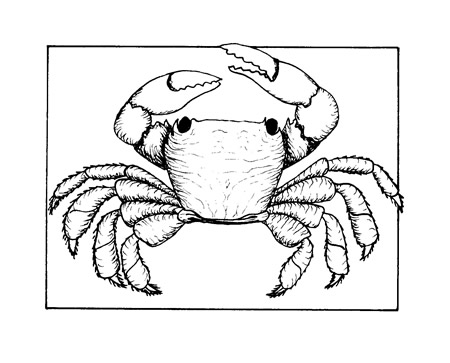Avoid Pinching Crabs

When wandering among the tidepools, who can resist watching little crabs scurrying across the surface of the rocks or along the bottom of a tidepool? Living in the upper intertidal zone under rocks, in crevices, in tidepools and within mussel beds, the most commonly seen crab in Laguna Beach is the striped shore crab (Pachygrapsus crassipes). As the most terrestrial of our local shore crabs, they are well adapted to spend time out of water.
Males are larger than females and the crabs reach their maximum size of three inches at 3 years of age. Outgrowing their shell several times in their lifetime, they molt through a slit in their back allowing a new, larger shell to harden a short time later. Their upper exoskeleton (shell) is rather square shaped and dark, in shades of reddish-purple to brown to black with greenish horizontal stripes across its carapace and it has light undersides. Wide-set eyes are located on the front of their carapace.
They have two heavy and mottled purple-red pincers (front claws) that they use for eating, defense and courtship. Like most crabs, they are omnivores that use their pincers to carry food to their mouths. Feeding mostly at night on algae and diatoms that they scrape off rocks, their diet also includes snails, periwinkles, limpets and other small invertebrates. Additionally they also scavenge on the occasional dead animal and at times will even display cannibalistic behavior by eating each other.

Reaching maturity at about 1 year, reproduction is sexual and usually occurs throughout the summer. After a courtship dance, the male turns onto his back and the female climbs on top of him and fertilization takes place. The female carries a clutch of up to 50,000 eggs that are held on her abdomen for about a month. When they hatch and are released into the ocean as larvae, they will settle to become juvenile crabs if they survive predation by fish and anemones. They have been known to produce one or two broods each year.
The striped shore crab has a range from Oregon to Baja California. However, there have been recent indications that its range is expanding as specimens have recently been found north of Seattle, Wash. Also, for the last century, the crab has been found in Japan and Korea however it is believed that they were introduced by ships voyaging from the eastern Pacific with larvae in the ballast water.
Striped shore crabs are solitary animals although they can be found with great abundance in some locations. Supposedly not territorial, they do tend to remain within a home range and will aggressively fight to defend their food with the larger crab always being dominant. Predators include gulls, raccoons, fish, rats and little humans who like to collect them in beach buckets! Plentiful striped shore crabs are an indicator of a healthy marine habitat. The temptation to pick them up should be avoided.
Residents and ocean swimmers Mia Davidson and artist Jan Sattler encourage everyone to protect Laguna’s coastal resources as you are enjoying th





[…] many crabs, striped shore crabs molt, meaning that they shed their hard shells as they grow too large for them. When they shed, they do […]